Shop Builds Ep 2: the Unicorn Epiphone G-400 Demo Guitar
Hey guys, this week we have something special for you!
Like most of you, our techs are avid window shoppers. Isn't there nothing better than hanging around local guitar stores or the occasional pawn shop, looking at all the random and unique guitars they have? Well, last week, one of our techs, found a unicorn Epiphone at a local pawn shop that needed some TLC. Why do we say it’s a unicorn? You are going to have to keep reading to find out.
Here's some background info of this guitar before we start
Manufacture Specs
built at the Unsung Plant, Korea
on March, 1999
Body:
Mahogany Body
Neck:
Set Mahogany neck
Rosewood fingerboard
Trapezoid Inlays
12" fingerboard radius
22 frets
24.75" scale
1.68" nut width
Electronics:
Alnico Classic humbuckers
2 Vol. 2 Tone controls
3-way selector switch
Hardware
Chrome
Epiphone stamped
Black reflector knobs

To call this Epiphone a "unicorn" is a tall order. and I don't know if we can live up to the name. But we will plead our case and explain to you why this is a rare example of essentially now a "Vintage Guitar"
"First off let’s talk about the elephant in the Room"

Besides how pretty the guitar is, The Body- when you read the specs you see that this guitar is made of "mahogany" your first thought is "Cool, just like a real Gibson" In this case "Mahogany" is a blanket term used to described a broad range of "Mahogany" Species. Gibson only uses what people call the "Genuine Mahogany" this is narrowed down to 3 species. Honduran mahogany-Swietenia macrophylla, and Swietenia mahagoni and West Indian mahogany-Swietenia mahagoni. Epiphone on the other hand is limited to what is the "best value". "Genuine Mahogany" is an expensive wood to manufacture with and to stay within Epiphones set retail price. It’s use is out of the question. So, what are Epiphones made from? This is an impossible thing to pin point. There is 17+ species of Mahogany, and there are endless variables that come to play. Things like,
1. Fluctuations in prices of wood which will affect what is used batch to batch.
2. Ever changing laws that will forfeit or limit the use of a species Epiphone once used. (think the raid on Gibson in 2011)
3. Environmental Causes which can wipe out and severely limit the total wood being produced.
the list goes on.

The Neck- This is no different than the body, when it comes to what mahogany was used. But, let’s talk about this guitar’s neck. While newer Epiphones are usually made of 3 pieces of "Mahogany" this 1999 version is made from 5 pieces of a "Mahogany" /Maple combo. That's right Maple. The Maple part of the neck looks to have been rough sanded right before staining the neck, creating a Faux Mahogany grain pattern.


So, why is this guitar a "unicorn"
the Body- this 1999 Epiphone G-400 features not only a 2-piece body but a 2-piece body that was properly "Final Sanded" which shows off the beautiful 3d wood grain.
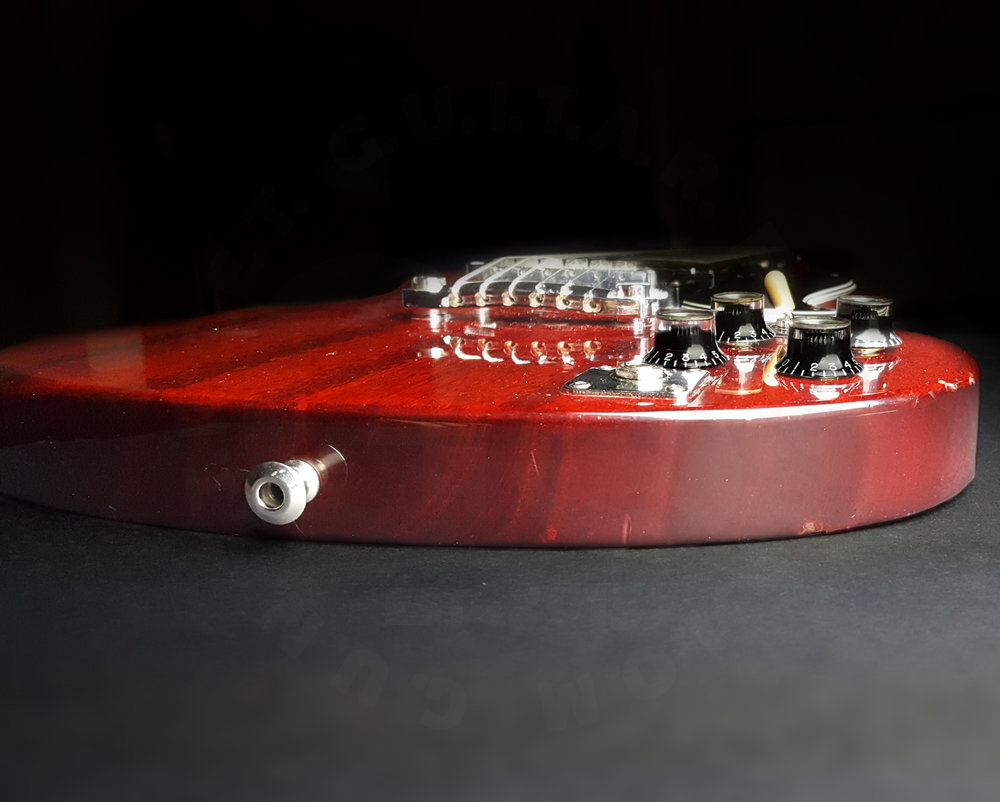


How is that rare?
The Body
Rough Mill- When buying wood in bulk for manufacturing, it comes on a pallet in a varied array of widths. Wide board tend to cost a lot more then thinner width board. So, to save money, manufactures will buy lumber that is mainly thinner width boards. You will tend to find that most Epiphone bodies are made of 3+ pieces. And, the lower the retail cost the more the number of pieces increases. So, the fact that this individual Epiphone has a 2-piece body is quite rare as the number of 2-piece bodies of the "Batch Year" has to be limited to a disproportional amount, which is maybe a handful of guitars out of hundreds.

The Sanding
A guitar that has been properly sanded is a sign of a quality craftsman. Why is that? We will answer that in two parts.
A. Final Sanding. To properly sand a guitar, you have to have a deep understanding of how it works. During building, a luthier will sand the guitar in a series of set grades of sandpaper. Each grade has a set goal and requires a keen eye to know when to switch grades. Switch to soon, deep scratches appear in the color coat. Wait to long and you created a whole new guitar shape. This process is time consuming and leads us to our second part.
B. Time Constraint. Whenever you ask someone "What makes a high-end guitar, a high-end guitar?" the most common response is the raw parts. the tone wood, the number of pieces, the electronics, the parts. While this is true, it is only half the story. The second part is how long they are allowed to work on the guitar. The higher the price the more hours spent, with a large chunk of those hours being spent on sanding. So, whoever sanded this SG did an amazing job in a short period of time.
Alright now that we are done explaining why this is a cool guitar. we will go into why we bought it.
As you may know. When we create products. We create a "demo guitar with a theme" Why? At Gunstreet we are obsessed with our quality. Not just our quality of craftsmanship but, the overall quality of the day to day experience, dealing with our products."
The Build
When we got this guitar, it was apparent that it needed some work. Besides the obvious damage to the control cavity, the neck pickup was dead. The previous owner had installed a Graphite Nut. But, the "A string" was filed down too low causing the string to "Buzz", so that needed to be replaced. The tuners were garbage and stayed in tune for an equivalent of just one song. Which because we plan to use this as a Demo guitar, that won't work for us. So, all this stuff, will need to be replaced
The Plan
the build is will go down in Four stages
Replace Tuners
Replace Nut
Sheilding
Replace the electronics
Parts List
Gibson Gear Tuners
Bone nut
Gunstreet Metric 50's Wiring
Gunstreet 6 Streeters Prototypes
Copper Tape
Bonus Goal- How close can we make this unique Epiphone play and sound, like its bigger brother!
- Replace Tuners
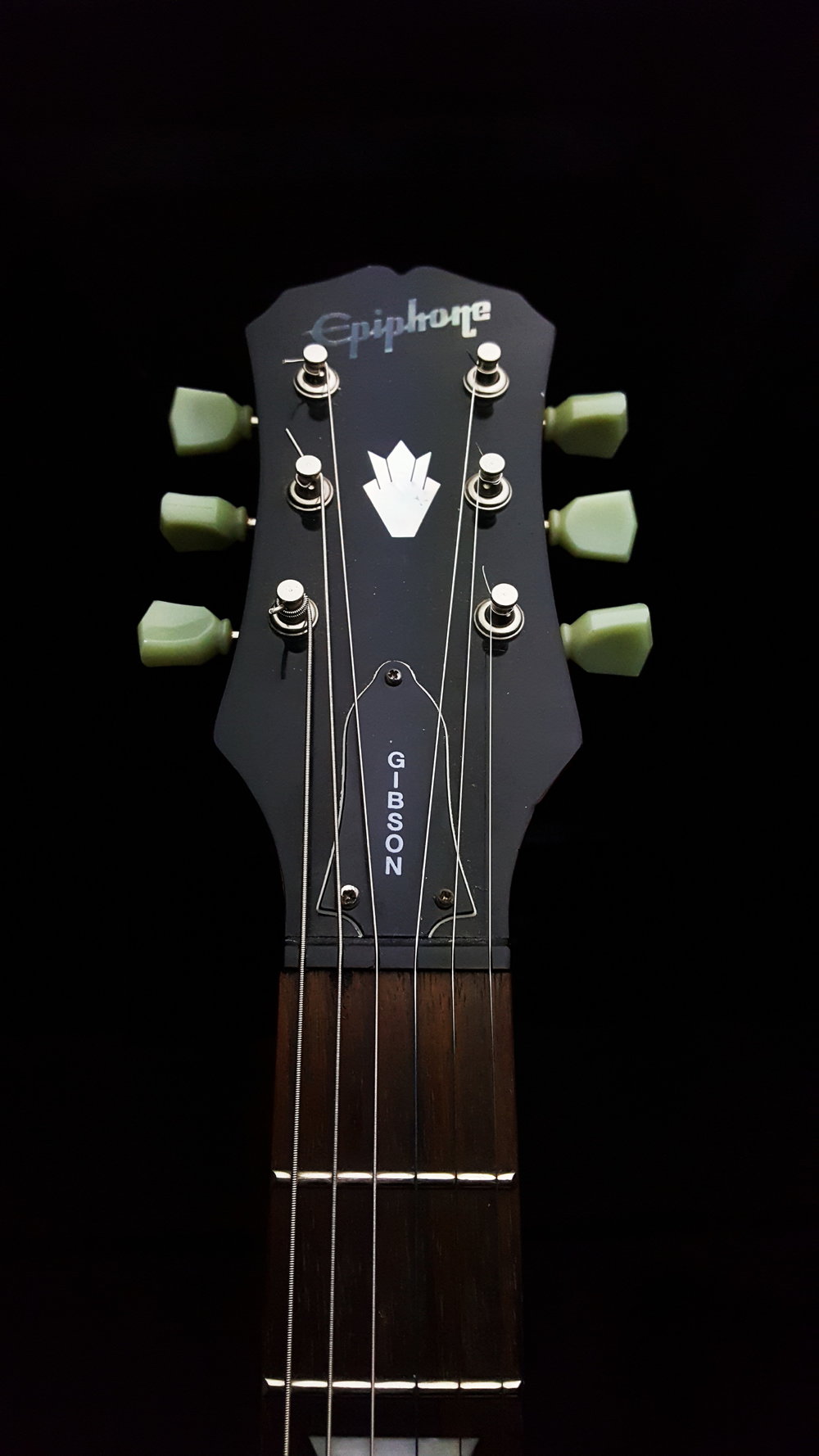
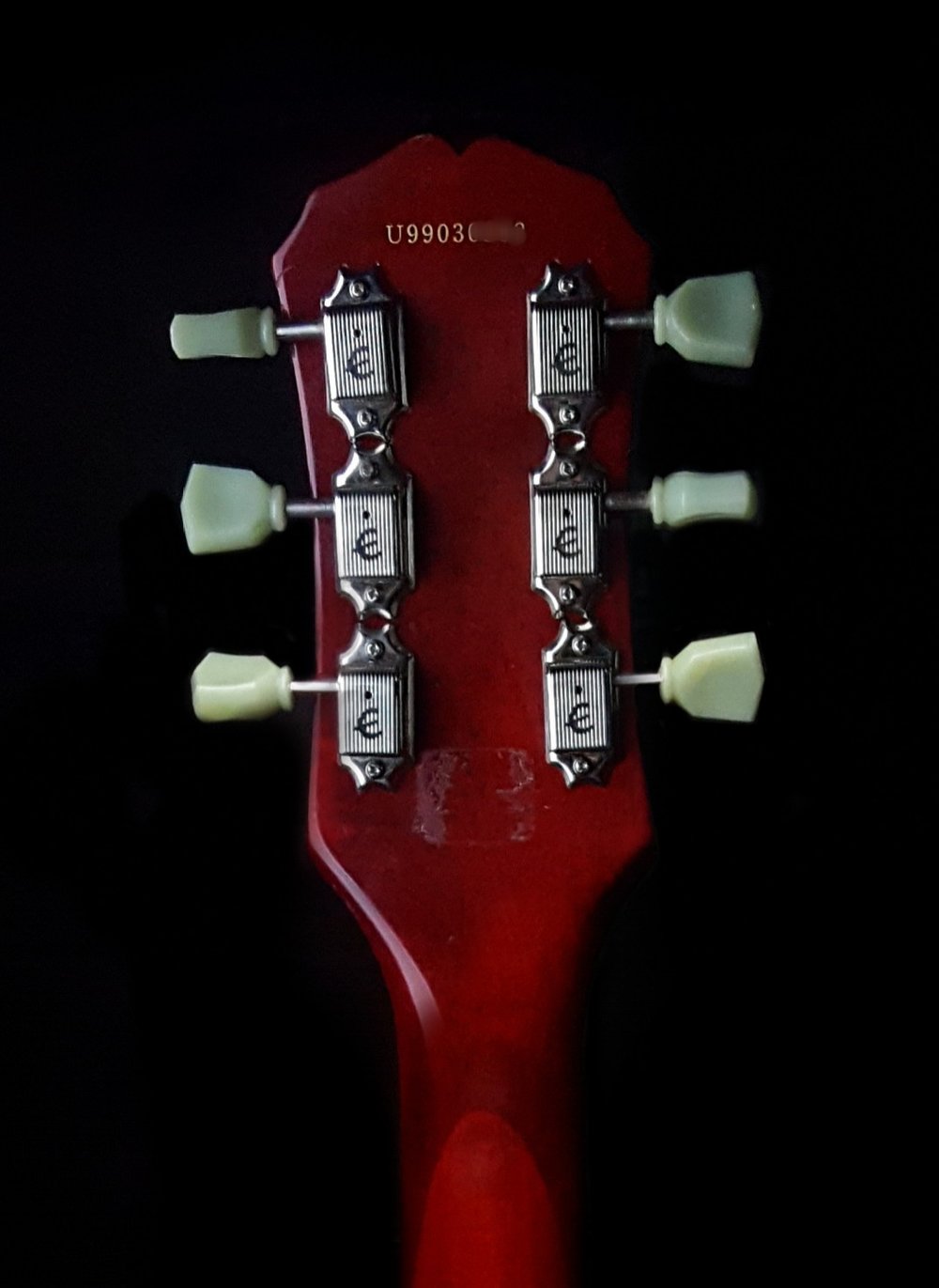
These "E" Epiphone tuners are a good value for your money. But for what we need we want tuners that will last a good amount of time. Gibson Gear tuners are not the best you can get, but they come standard from a wide range of Gibson SG
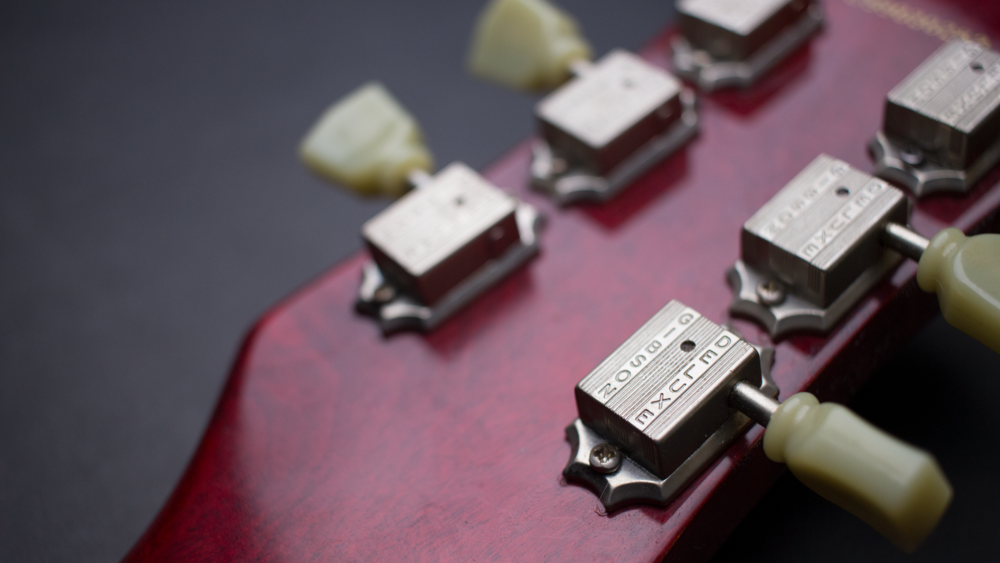
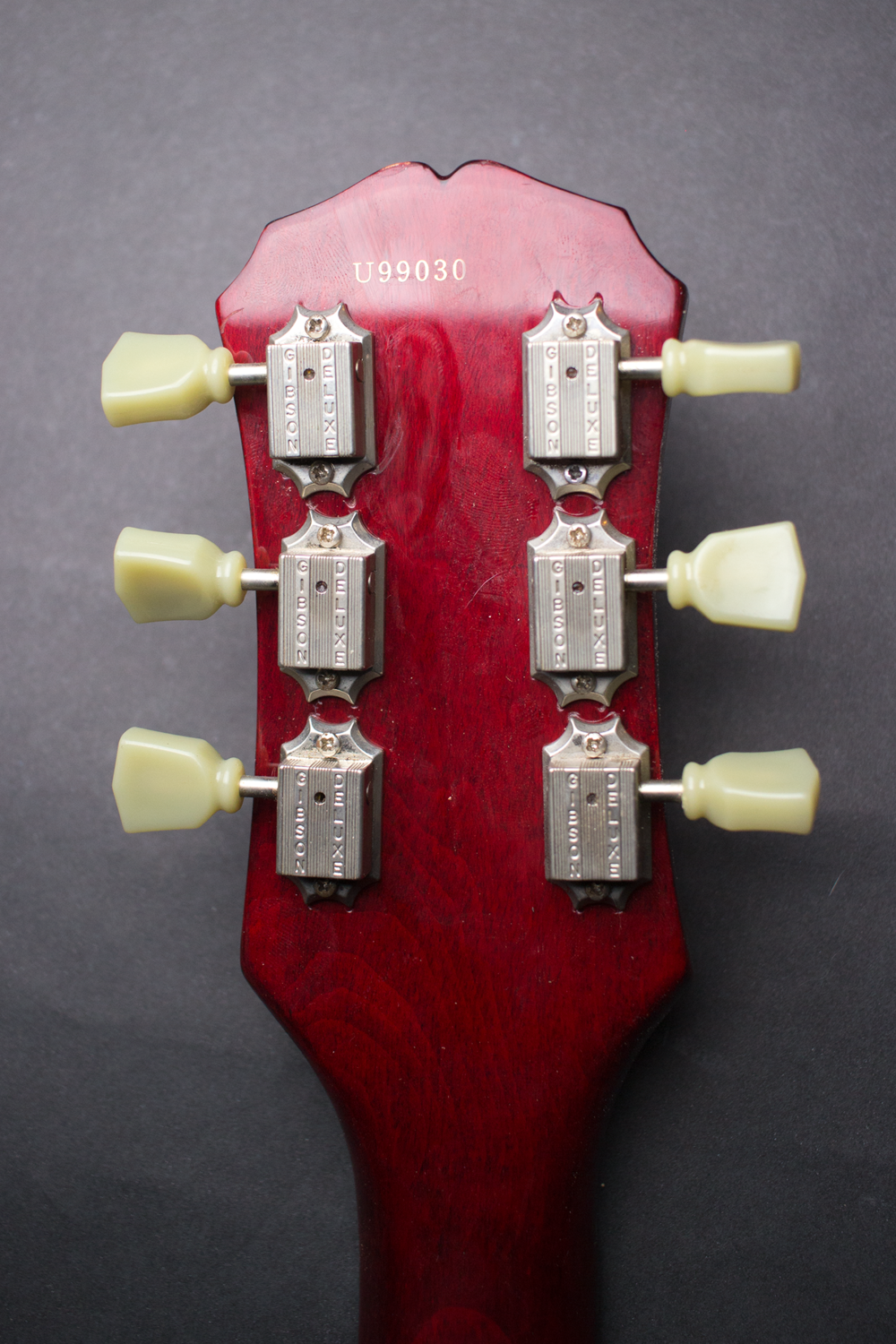
In order to install the new Gibson tuners, we had to enlarge the stock holes. This is a mod that we truly must stress caution when doing, as it requires a set of proper tools so as not to damage the finish.
Replacing The Nut
As you can see the previous owner filed down the A String to far Down. We will replace this with a Epiphone sized Bone Nut
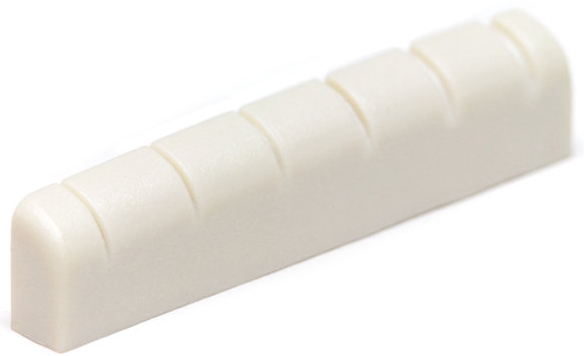

Stage - Shielding
This guitar is going to become a demo guitar for us. So, we are going to push this guitar to it’s max. Putting this guitar in front of high wattage amps, this guitar's wiring will need to be shielded.

Why Shield?
We live in a world that is filled with electrical frequencies that affect your guitar’s electronics. things like fluorescent lights, cell phones, electrical dimmer outlets, all create radio-frequency interference. this sneaks into your guitar. How do you stop this? One way is to create a Faraday Cage. To super simplify it, this "Cage" creates a shield. you can make this "cage" by lining the inside of the guitar cavities with copper tape. This copper tape when properly grounded, acts as a shield, blocking all the random frequencies crashing onto the guitar.
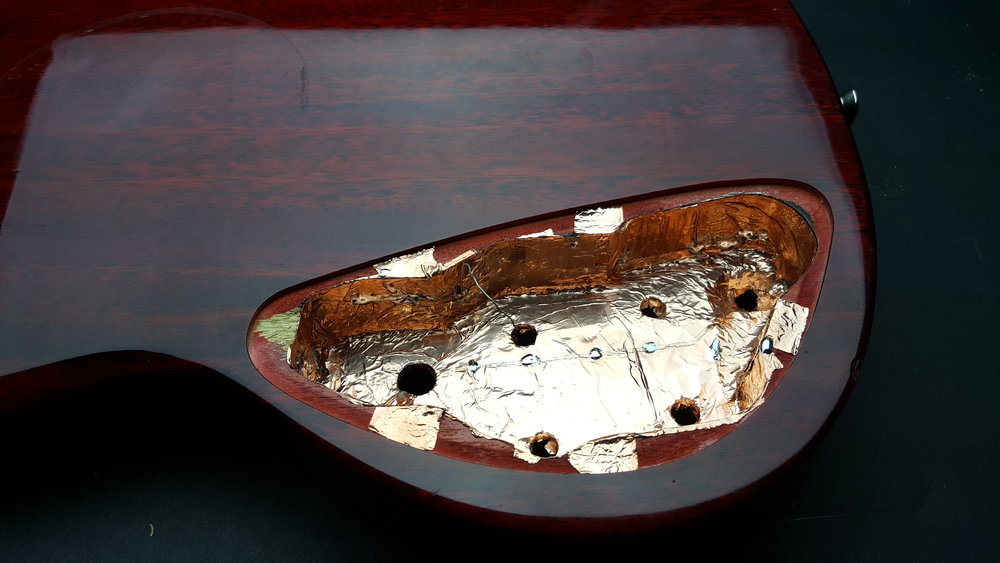
Replacing the Electronics
When we started to plan this guitar build, we had to think about what makes a sg, a good sg. Historically the Sg is known as a powerhouse guitar. Bands like, Rush, The Who, The Doors, Cream, all favored the guitar for it's tonal qualities. but, two bands really made their mark on the sg. And, really defined the guitar forever. AC-DC and Black Sabbath. Two bands whose whole sound was the sg. With this agreement we sent off to make a guitar that in bodies the tone of those bands.
Replacing Electronics Part I - Wiring
To us a good SG is like having an atomic bomb at your disposal. The way the SG was designed, it already had a distinct tonal resistance that breeds a powerful tone. Add the high pass filter of the 50's and you have a guitar you cannot beat!
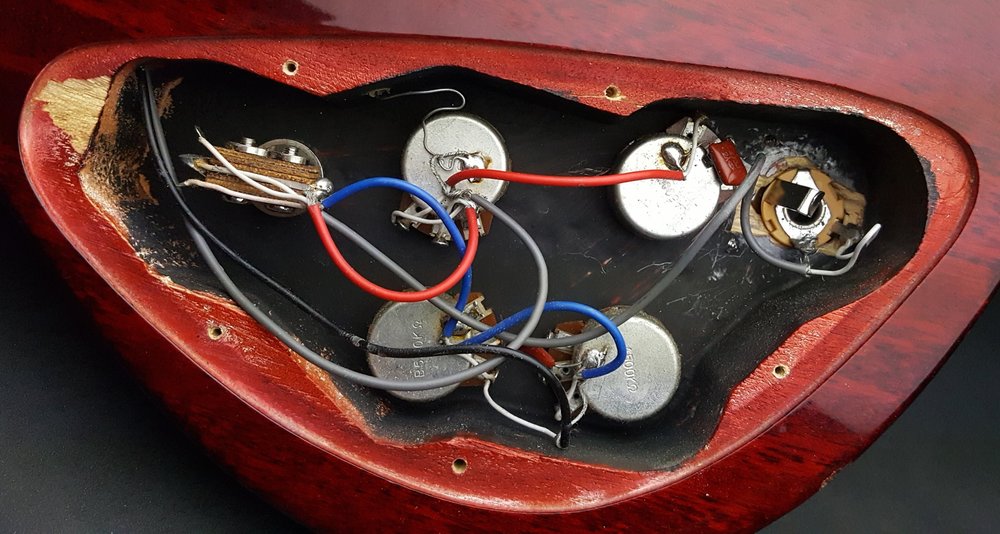
Stock Epiphone Wiring Vs Gunstreets 50's Wiring
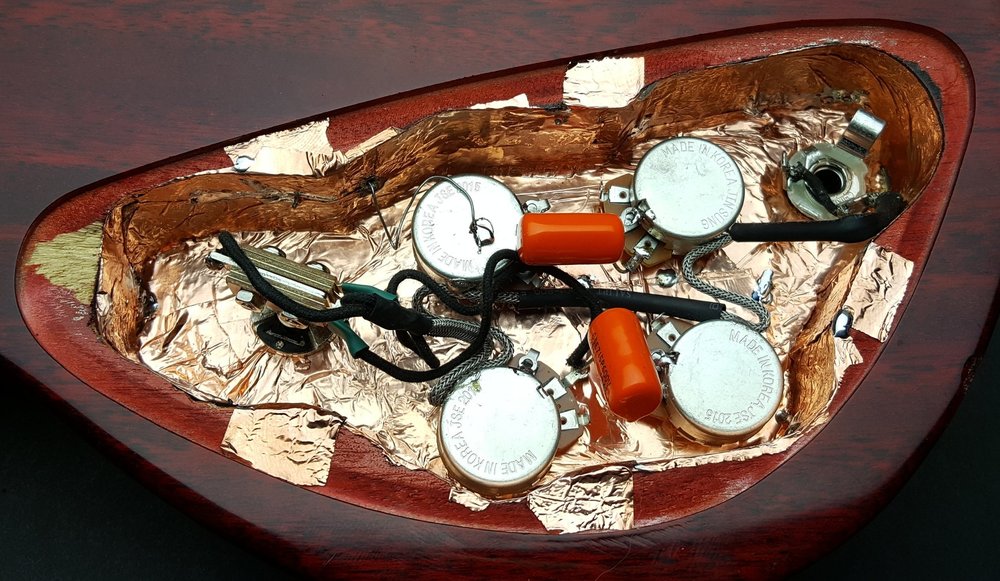
Stock Wiring-Stock Wiring This guitar comes stock with Modern Wiring and features "Tick Tack" 0.022uf Capacitors. The harness is wired using "Shielded" Pvc wire and Linear Pots in the Volume Controls and Audio Pots in the Tone Controls
Gunstreet 50's Wiring-This harness is wired to some of the standards of Epiphone parent brand Gibson. Using Braided and Cloth Wire. This harness features CDE "Orange Drop" Capacitors.
Pots-
Epiphone- This harness uses linear Pots in the volume and audio Pots in the tone. In most cases this is reversed. People find that Audio Pots are best used as volume controls. Linear Pots have a better control as tone controls.
Gunstreet- Gunstreet- uses Audio Pots for both the Volume and Tone Controls
Wire-
Epiphone uses Shielded Pvc Wire ,which is a cost effective way to wire the guitar.
Gunstreet uses Both Braided Cloth Wire and Cloth Wire. Wired just as you would find in Vintage and High End Gibson SGs.
Capacitors-
Epiphone- this harness features what people call Tick Tack Capacitors. These Cheap, Working Horse Capacitors, usually cost as much change as you can find in your couch.
Gunstreet -Uses CDE "Orange Drop" Capacitors, which is known to be the top of the line capacitor. As it is found in most high end Guitars
Intermission-Detail Shot Break
We included some detailed photos of just how pretty the wood is. Take notice of the damage located where the output jack was. The damage went all the way from the output to the Neck Tone Pot.


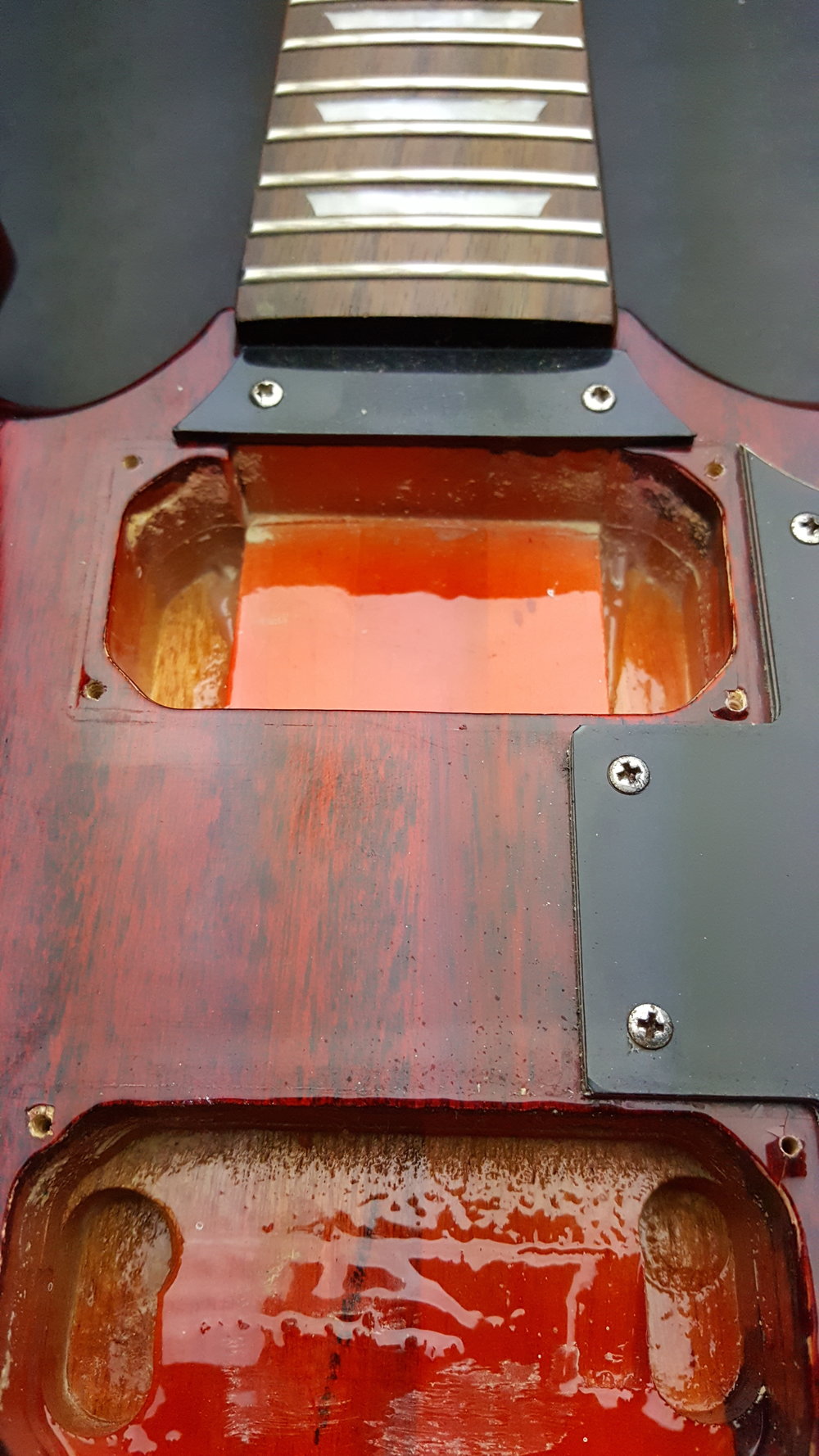
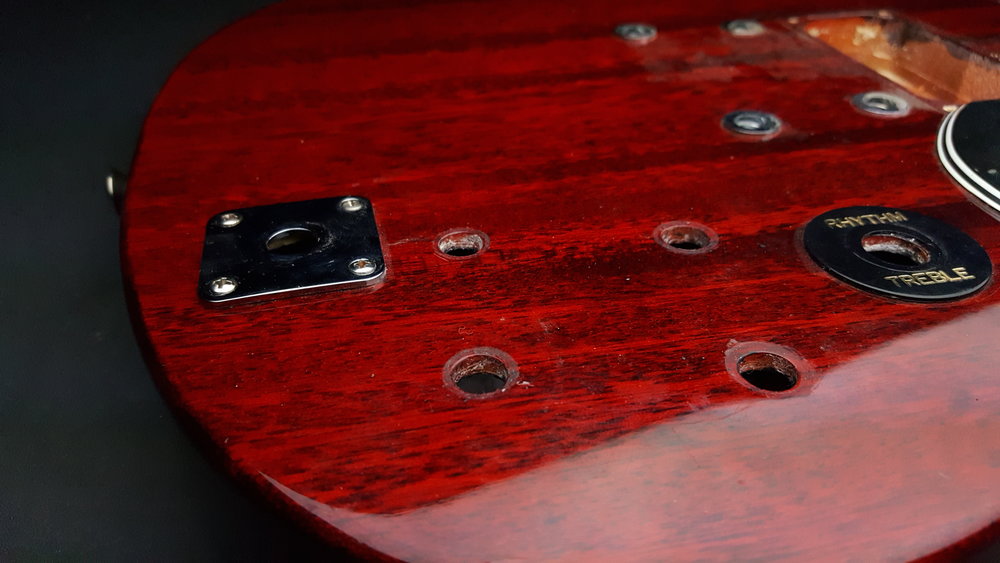


Replacing Electronic Part II - Pickups
In these Shop Builds Series We worked with Multiple Pickup Manufacturers to make what we call 6th Streeter's Batch Pickups. These Custom, High End, Limited Batched, Bouquet Humbuckers are numbered by Manufacturer and are designed to match whatever your playing style is.


6 Streeter Prototype
With the Batch No.1 Series. The Master Winder designed a pickup that is truly three dimensional. Listen as you hear the high clarity of the Bridge Pickup. Which if you aren't careful Packs a Punch. Or, the Powerfully Deep Neck Pickup as it Commands the Lower Strings and Rhythm
Specs
Scatter wound - AWG 42 Gauge Wire-Custom Tonal Wax-Bridge Magnet-Alnico V-Bridge Magnet-Alnico 2
Bonus Stage-


This guitar at one time had two stickers on it, which we want to clean off. how do you do that? Just like how we cleaned the black dog demo guitars case. Soapy water and a micro-fiber rag


That’s it. Another cool shop build. If you see us hanging around your local guitar store, or at a local guitar event, come check out how amazing this guitar truly is!
Like these Shop Build Series? Check out our other builds. Or, if you are looking for something else try out our "Tech Talk Series"
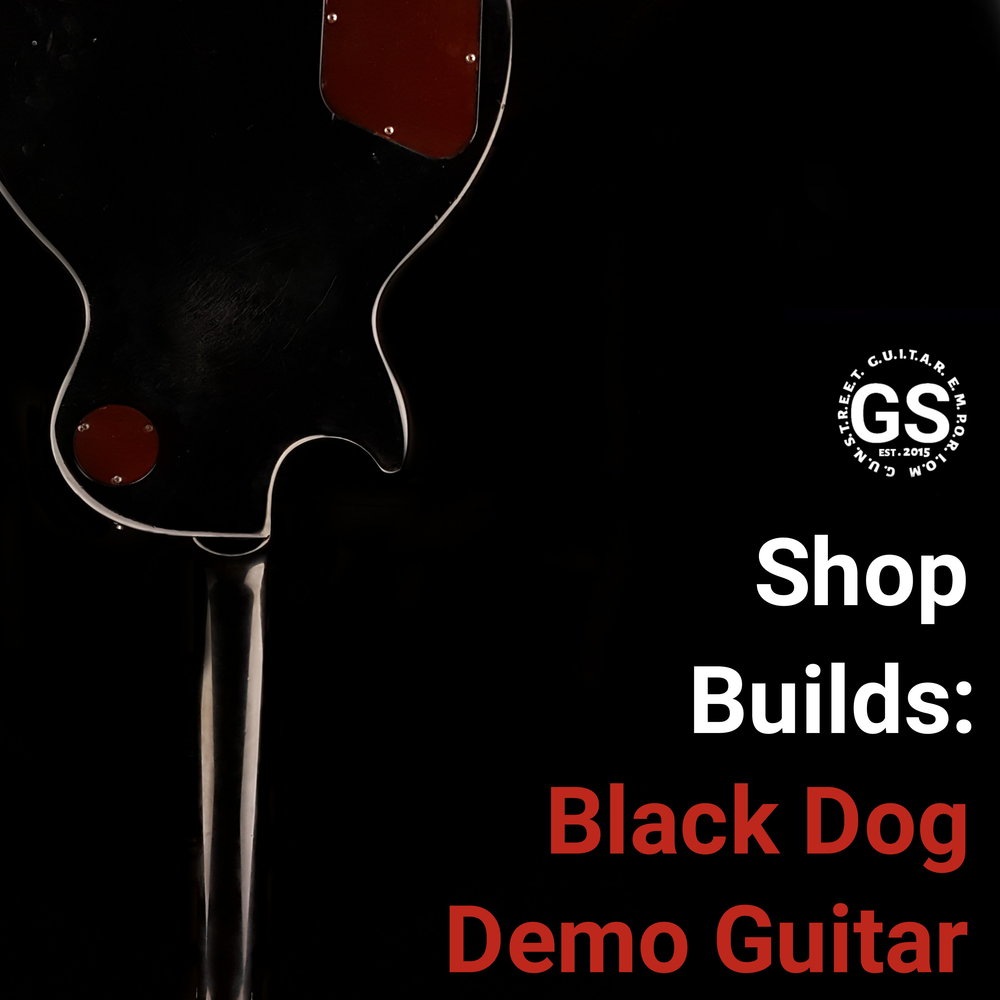



Leave a comment
This site is protected by hCaptcha and the hCaptcha Privacy Policy and Terms of Service apply.